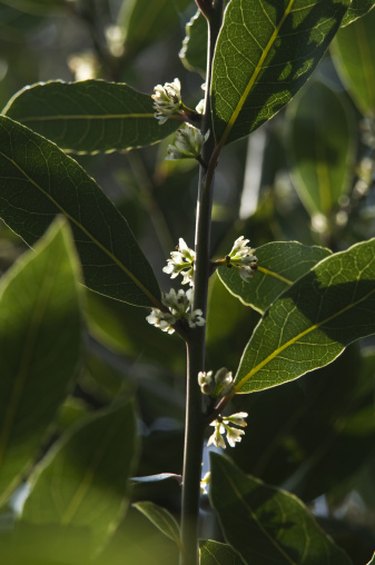
California bay laurel (Laurus nobilis) is an evergreen that can grow up to 75 feet tall. According to the University of California Davis, it has several insect pests, including aphids, beetles, borers and scale. Identify which insect has been munching on your bay laurel's leaves, and you'll have much better idea of how and when to kill them. Not all insects are treated the same way, and not all insects should be controlled with chemicals.
Step 1
Look for sooty mold on bay laurel leaves and twigs. This is the excretion of laurel aphids, soft-bodied, pale-green insects that damages leaves by blocking light and reducing photosynthesis. Laurel aphid also excretes a sticky, sugary substance called honeydew, and it drips off affected leaves and stems. Badly infested leaves eventually curl, yellow and drop.
Video of the Day
Step 2
Check twigs and leaves for grayish brown, 1/8 to 1/4-inch lumps, clustered together. This insect is called scale, and there are several varieties that attack bay laurel. They can be soft or armored with a waxy coating that helps them overwinter. Scale sucks fluids from twigs and leaves through tiny, straw-like mouth parts. They generally won't kill a bay laurel, but they can be unsightly in masses.
Step 3
Examine twig ends for tiny holes if your bay laurel's leaves are wilting. Look for 1/2-inch, brown beetles, a little farther back on the branch. Branch and twig borers drill into tender bark at branch tips, and even leaf buds, causing wilt. Prune affected branches back to healthy wood to control these insects without spraying. In their larval stage, twig borers look like small, white grubs, curled into a "c" shape.
Step 4
Check branch and twig crotches for curving, tan-colored tunnels in the bark. If you find them, you've got leadcable beetles. The insect is about 1/4-inch long at maturity and its head has a slightly fuzzy appearance. Though they're not technically leaf eaters, their activity affects leaves by causing twig dieback.
Tip
Treat beetle and borer problems with careful pruning and disposal of affecting wood. Don't allow dead wood or diseased leaves to collect, or more insects will breed.
Warning
Apply insecticides for aphid and scale control, paying careful attention to the directions and timing of application. Sprays used on armored scale must be applied before they form a waxy, protective coating.
Video of the Day